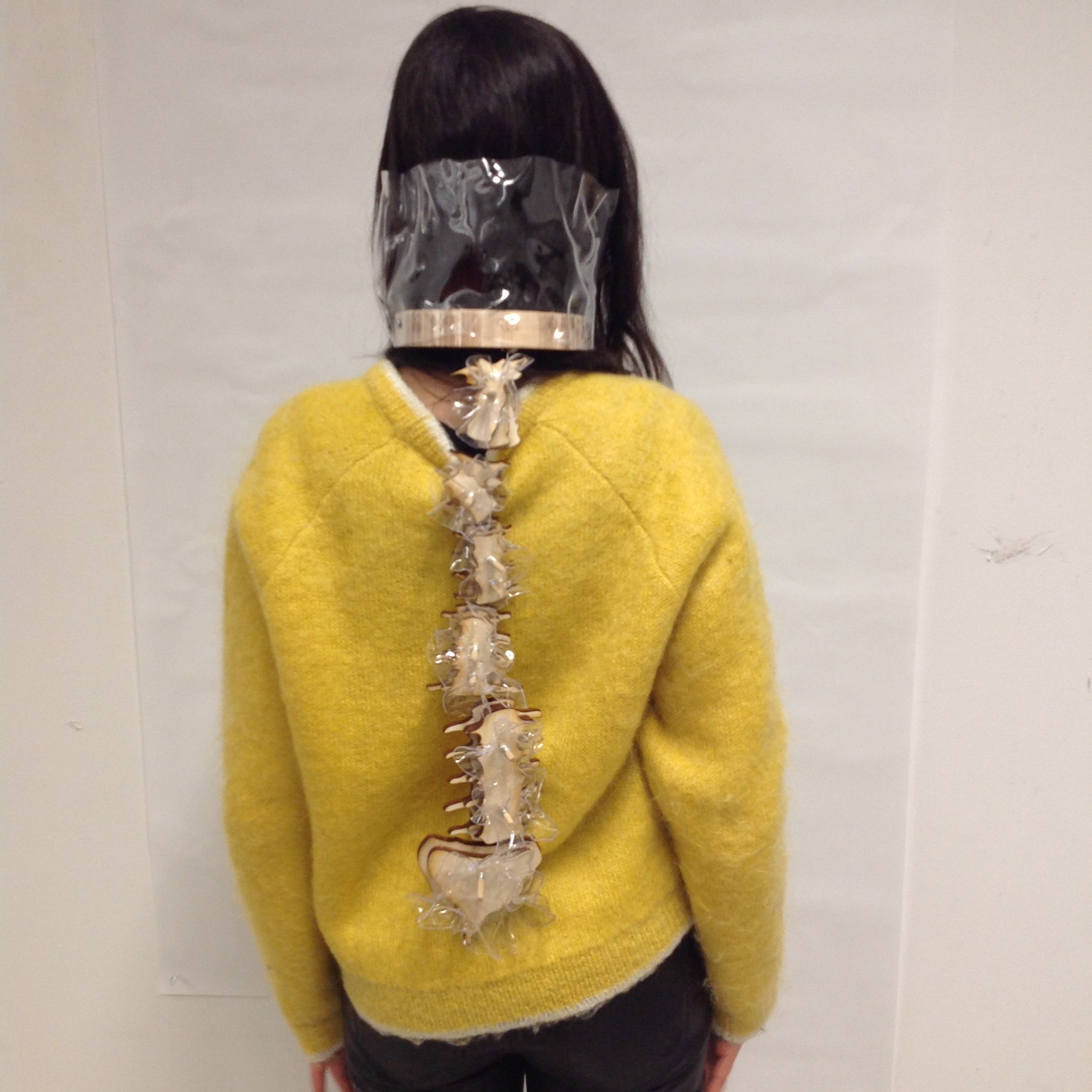Planar Construction Problem: sheet metal combined with redirected aluminum cans.
Form Wheel "Verb List": Cardboard
Joinery Projects: Wood and paint (students explore joinery options without glue or fasteners).
Chair problem: student investigates how the body can be supported using the architectural elements of column and floor.
Halloween Problem: Make something pictorial, abstract, functional, that is additive to your body.
Lines in Space with Wire
Paper Dodecahedron: Interior surfacing project, paper, metal fasteners and string.
Chair / Stool Problem: Students must create a chair or a stool using cardboard with mechanical joints (no glue or tape).
Cubist Problem: Initially a project to articulate cubist notions in dimensional form using wood. This student redirects cubist methods into making head more pictorially surreal.
Rectilinear Planes Project: Cardboard and Paint
Cantilever Problem: Students were asked to make an object that models how a cantilever mechanically functions. In this case, student uses his body as the structural anchor to extend this dress like (chicken wire, plastic tubes and white tissue paper) exoskeleton.
Materials Economy or Life Cycle of an Object project: Students take apart a consumer object, and research the materials from extraction, production, distribution, consumption to disposal. The research is designed as an info-graphic for final project presentation. After research is completed for info-graphic, students redirect/reassemble their object fragments into another object. The above example are the fragments from a Bonvoyage nylon handbag, combined with chickenwire, decoupaged tissue paper, and acrylic paint.
Student Info-graphic based on reading of chapter, "Basic Observations" from Steen Eiler Rassmusen's book, Experiencing Architecture. Students read this chapter at beginning of semester, to learn, understand how and why materials "express" through the built environment.
Materials Economy or Life Cycle of an Object project: Students take apart a consumer object, and research the materials from extraction, production, distribution, consumption to disposal. This research is designed as an info-graphic for final project presentation. After research is completed for info-graphic, students redirect/reassemble their object fragments into another object. The above example are the fragments from a Chinese cloth bag (backpack) re-directed, sewn into two smaller carrying bags, one for artist painting brushes.
"Interventionist Art" final project, NYU "Art and Public Policy" graduate course: Students had to write a manifesto based on their social and political convictions at the end of the semester. Then create an "interventionist" art piece with the notion of public engagement in mind. In this case, student interacted with strangers in a NYC subway station.
"Lines In Space": Students learn the vocabulary of lines in space (11 lines), by soldering the wire lines, clearly articulated, into a larger wire shape.
Display of "Materials Economy/Life Cycle of an Object" project: Students take apart a consumer object, and research the materials from extraction, production, distribution, consumption to disposal. This research is designed as an info-graphic for final project presentation. After research is completed for info-graphic, students redirect/reassemble their object fragments into another object.
"A shoe is a built Environment for your foot" project: Students bail a wire shoe (mechanical joints), based on an actual size shoe, that has architectural or sculptural elements added (wood, plexi-glass, etc) to final piece.
Various beginning problems, studying rectilinear and curvilinear volumes. These studies are usually made out of bailing the wire or soldering the wire, to create implied volumes. Wood volumes have OLU joints that are mechanically put together. Finishing these pieces, students cover sections of wire, either by surfacing to create planes, decoupage the wire to clarify the forms of the curvilinear volumes, and paint wooden rectilinear volumes to articulate one volume from the next in the grouping.
Wooden Fashion: using wood and mechanical joints (no glue or tape) create an object that is an accessory to your body. This student made a baseball cap from wood, using wood joints, screws and brass ties.
Piece Mold/Cast problem: Students design a dimensional form out of plastercine clay, to make a plaster mold from in order to generate plaster casts. The piece mold/cast problem usually requires student to design an "interlocking" single form to be repeated 5 times from mold. The "interlocking" single form casted 5 times, should create an one assembled grouping.
3D homework sketch: Students are asked to make something sculptural out of a small everyday consumer item, not adding surfacing to cover object. They have to see what the larger object is assembled from. The item is repeated many times, using appropriate glue to material, until the repeated item is transformed into another different larger object.
Cubist head Problem: Using cubist concepts to create 3d head. This student used scrape wood, wire mesh, plastercine clay and drywall screws.






